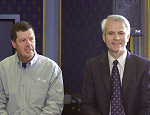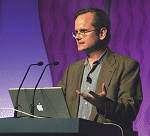CT at the Show
Open Communities, Eco-Computing, and Education 3.0.
Sun's Worldwide Education and Research Conference 2008
 GLOBAL, OPEN, AND GREEN. Earlier this year in San Francisco, Sun Microsystems' (www.sun.com) Worldwide Education and Research Conference (WWERC) brought together about 500 thought leaders in education and technology from around the globe and across disciplines. Conference sessions focused primarily on the power of communities, green computing, and the evolving and socially connected applications that may lead from Web 2.0 to "education 3.0." Sun's strategy of open technology figured prominently. Sun Vice President for Global Education Joe Hartley (at right) hosted the WWERC event, opening with "How Open Communities Will Change the Future of Education." Sun Chairman and Founder Scott McNealy's (at left) keynote, "Open Wins, Global Education in the 21st Century," spanned Sun's specific technologies and strategic directions in McNealy's always matter-of-fact, often humorous style.
GLOBAL, OPEN, AND GREEN. Earlier this year in San Francisco, Sun Microsystems' (www.sun.com) Worldwide Education and Research Conference (WWERC) brought together about 500 thought leaders in education and technology from around the globe and across disciplines. Conference sessions focused primarily on the power of communities, green computing, and the evolving and socially connected applications that may lead from Web 2.0 to "education 3.0." Sun's strategy of open technology figured prominently. Sun Vice President for Global Education Joe Hartley (at right) hosted the WWERC event, opening with "How Open Communities Will Change the Future of Education." Sun Chairman and Founder Scott McNealy's (at left) keynote, "Open Wins, Global Education in the 21st Century," spanned Sun's specific technologies and strategic directions in McNealy's always matter-of-fact, often humorous style.
At a press conference, CT interviewed McNealy and Hartley about patent issues, digital repositories, and the Sun Preservation and Archiving Special Interest Group (Sun PASIG). McNealy commented on the importance of the Sun PASIG effort: "When we bought StorageTek, people said, 'Archives, tape-how boring.' And I said, 'You want to see excitement? Go in and tell the CEO or the CIO that you've lost his archives. Then you'll see excitement. You'll have to peel that guy off the ceiling!' So, [data protection is] a very, very hot topic." Read more here.
 SPEAKING WITH THE STARS. Among a seemingly limitless galaxy of sought-after speakers was Larry Lessig, Stanford University (CA) professor of law and founder of the school's Center for Internet and Society. Lessig moderated a discussion on "Intellectual Property in the Digital Age: Enabler or Detractor to Community?" with panelists Stuart Sim (of Moodlerooms), Gerry Hanley (of MERLOT), and author Neil Howe.
SPEAKING WITH THE STARS. Among a seemingly limitless galaxy of sought-after speakers was Larry Lessig, Stanford University (CA) professor of law and founder of the school's Center for Internet and Society. Lessig moderated a discussion on "Intellectual Property in the Digital Age: Enabler or Detractor to Community?" with panelists Stuart Sim (of Moodlerooms), Gerry Hanley (of MERLOT), and author Neil Howe.
 FIRESIDE CHAT. Sun Chief Researcher John Gage's tradition of "fireside chats" was sent into orbit this year, as he explored "The Importance of University and Industry Collaboration" with scientist, astronaut, and educator Kathryn Sullivan.
FIRESIDE CHAT. Sun Chief Researcher John Gage's tradition of "fireside chats" was sent into orbit this year, as he explored "The Importance of University and Industry Collaboration" with scientist, astronaut, and educator Kathryn Sullivan.